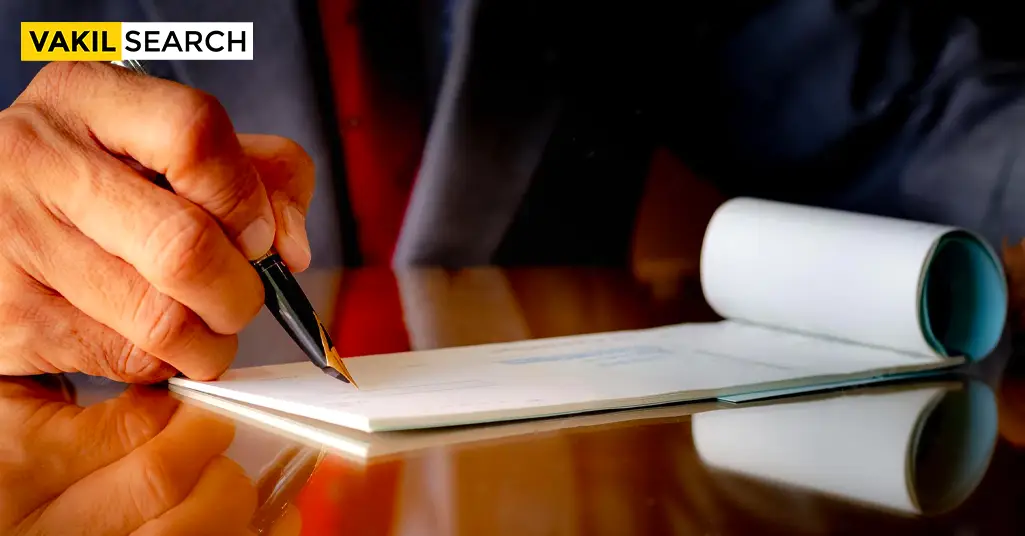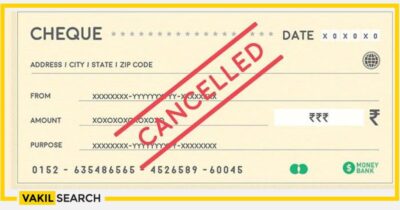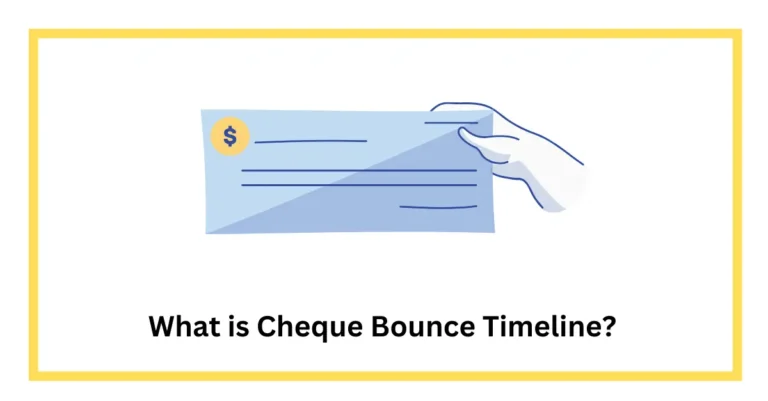The accused has the opportunity to employ the defences available to him to establish his innocence and enter a not-guilty plea because the burden of proof in a cheque bounce case is on him.
Cheque Bounce Case are a popular form of payment nowadays, and post-dated cheques are regularly utilised in transactions. When this mode of payment gained popularity, there have been instances where the checks have been dishonoured or bounced, preventing the payee from receiving payment for the goods or services they provided. It was subsequently realised that this act of dishonoured or returned checks ought to be criminalised. As a result, inadequate funds in the drawer’s account led to the criminalisation of writing checks in 1988. The Negotiable Instruments Act of 1881, an old British legislation, was modified to make such an offence a criminal.
Connect with Vakilsearch for all of your check bounce cases, Vakilsearch is continuously attempting to improve access to the legal check bounce case procedure in India. The best guidelines and rules are known to us. Here are some explanations for why you ought to pick us:
- There are no extra costs
- Your confidential information is safeguarded and kept secret
- You can access the best legal professionals working today.
Cheque Bounce
Cheques that bounce are ones that the bank returns unpaid because, among other things, there are not enough funds in the drawer’s account. They are also referred to as “dishonoured cheques.” The payment paid by the drawer to the drawee is dishonourable for a number of reasons. In accordance with the legislation, the individual issuing the check is referred to as the drawer, and the beneficiary of the payment is referred to as the drawee.
The definition of “cheque” under section 6 is also included in the Act. A cheque is described as a bill of exchange drawn on a particular banker that is not immediately payable elsewhere. It is a drawer’s or depositor’s order at a bank. A cheque has three parties: the drawer, the drawee, and the payee. The cheque has a set expiration date of three months. This means that starting on the date of issuance, any cheque may expire or become invalid.
Defence Techniques For The Cheque Bounce Case
Since the burden of proof in a cheque bounce case rests with the accused, he may employ the defences to establish his innocence and enter a not-guilty plea. The accused may invoke any of the following defences:
-
When a cheque is given as security rather than to pay off a debt
The accused must demonstrate in this defence that the cheque was written as a security deposit rather than to pay off a debt or other obligation so that the case does not violate Section 138 of the Negotiable Instruments Act.
-
Friendly credit is provided for the missing funds
Section 138 of the Negotiable Instruments Act does not apply to the need to pay the unexplained cash sum. Therefore, a loan of unaccounted cash for whatever amount would not be eligible for legal recovery.
-
The accused contests the signature on the cheque
Only then could the banking provide proof of the mismatch of the signature on the cheque, as long as the accused himself calls the court’s attention to it.
-
“Stop Payment” as directed by the drawer if there are insufficient funds for some other reason
According to a complaint filed by the complainant under Section 138 of the Negotiable Instruments Act, the drawer stopped the transaction, causing the cheque to bounce. If the defendant can show that there were adequate funds to cash the cheque but that there were other factors contributing to the payment being halted, then section 138 of the Act would not be applicable.
-
The Negotiable Instruments Act Section 139
The accused is presumed to be innocent unless and until the contrary is established. The prosecution may be unable to establish a case under Section 138 of the accused in such a case provides his defence that could raise a reasonable doubt regarding the legal enforceability of the debt.
Causes Of Cheque Bounce
When a cheque Bounce is returned unpaid or bounced, the bank writes a cheque return memo outlining the reasons why. Potential causes of a bounced check include the following:
- The drawer’s account is insufficiently funded
- The account holder themselves have stopped the payment
- Not enough opening balance
- The drawer’s signature does not match up
- The cheque has been overwritten
- The cheque was provided after it had been good for three months, so it is no longer legitimate
- The drawer’s account has been closed
- There are discrepancies between the wording and numbers on the cheque
- if a company issues a cheque but it does not bear its seal
- The account number does not match.
- The drawer’s check must have been delivered to the financial institution while it was still valid, which is three months after the check’s issuance.
If you’ve been the victim of a Cheque Bounce, you need Vakilsearch to assist you in the entire process.
Conditions Necessary To Commit The Offence Described In Section 138
- The drawer’s cheque must have been presented to the bank during the cheque’s validity period, which is three months from the date of issue
- The payee must first have given the drawer a written demand demanding payment of the specified amount within 30 days if the bank returned the check as unpaid for whatever reason, accompanied by a receipt for the information on the bank’s cheque bounce
- The drawer has not yet made the required payment within 15 days of receiving the notice, even after it was sent.
Conclusion
The Negotiable Instruments Act serves to prevent the misuse of checks and makes sure that transactions go off without a hitch by punishing the offence of a failed check. The accused also has defences available to prevent false cases of check dishonour or bounce. However, occurrences of cheque bounce must be handled with particular caution since they are so complex and demand exceedingly accurate verification of the transactions. It is distinct from other offence situations. We at Vakilsearch are always working to improve access to the legal cheque bounce case procedure in India. our experts will assess your situation and advise you on the best course of action.
FAQs
What is Defence evidence in a cheque bounce case?
Defence evidence encompasses any information or documents you present to counter the complainant's claims and prove your innocence. This can include: Documents proving insufficient funds: Bank statements or passbooks showing sufficient funds were available in your account when the cheque was presented. Proof of stop payment instruction: Documentation confirming you issued a stop payment order before the cheque was presented. Evidence of technical error: Statements or reports demonstrating a bank error or technical issue that hindered the transaction. Proof of mistaken identity: Documents establishing the cheque belongs to someone else with a similar name or a possible case of mistaken identity. Witness testimonies: Statements from individuals who can corroborate your version of events or support your defence claims.
How do you disprove a cheque bounce case?
To disprove the case, you need to convince the court that the essential elements of Section 138 are not met. This means demonstrating the following: There was no intention to defraud: You had a reasonable expectation that the cheque would be honoured upon presentation. Technical or procedural issues caused the bounce: Bank error, stop payment, or insufficient funds due to circumstances beyond your control played a role. The claim is false or fabricated: The complainant's allegations or evidence are inaccurate or lack merit.
How can we escape from a cheque bounce case?
How do I settle a bounced cheque case on a cheque?
Settlement is a viable option to avoid protracted legal proceedings and potential penalties. To achieve this: Communicate with the complainant: Express your willingness to resolve the issue and negotiate a settlement amount. Seek legal advice: Consult a lawyer to understand your options and negotiate a fair settlement agreement. Formally document the settlement: Once agreed upon, ensure both parties properly document and sign the terms.
How do I settle a bounced cheque case on a cheque?
Settlement is a viable option to avoid protracted legal proceedings and potential penalties. To achieve this: Communicate with the complainant: Express your willingness to resolve the issue and negotiate a settlement amount. Seek legal advice: Consult a lawyer to understand your options and negotiate a fair settlement agreement. Formally document the settlement: Once agreed upon, ensure both parties properly document and sign the terms.









